
Jim Davy
Wildflowers are angiosperms, meaning that they are vascular, flowering plants that produce seed. Blooming wildflowers get visitors dreaming of the coming of spring at the park. Under the forest canopies, wildflowers provide views and smells throughout the park. Most often seen in sunnier, more open sections of the forest, wildflowers often dot the edges of trails or along the creek banks. The following wildflowers can all be spotted in the park by the observant visitor!
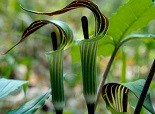
Jack-in-the-Pulpit, Arisaema triphyllumJack-in-the-pulpit is one of the most visually interesting flowers in the Prince William piedmont forest. Standing one to three feet tall, the stalk offers jack a commanding view of the forest congregation during the April and May blooming period. The flower, at the same height as the leafy stalks, has a pale green exterior extending into a leaf which curls roof-like over the pulpit. The inner surface of the flower is darker green with white and brownish-purple stripes. In the fall a cluster of bright red berries provides food for birds after the flower has withered. The root of this plant, if eaten raw, can cause a severe burning sensation and possible blistering and swelling of the mouth and throat. 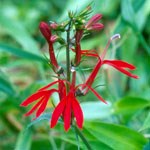
NPS photo Cardinal flower, Lobelia cardinalisThe cardinal flower, Lobelia cardinalis, so-called because of its similarity to the bright red robes of Catholic cardinals, flames among the forest plants from May through October. Standing one to six feet tall, the bright red flowers bloom primarily along streams or in wet, moist areas. Interestingly, because the floral leaves emerge from an extremely narrow tube at the base, insects find it difficult to reach the pollen, leaving propagation of this plant to hummingbirds. The lower portion of the stem is lined with lance-shaped green leaves. 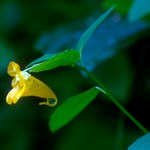
NPS photo Spotted Touch-Me-Not, Impatiens capenesisThe small orange flowers of the spotted touch-me-not, Impatiens capenesis, decorate stream banks and swampy areas July through September. The implied warning in the name refers to the explosive quality of the seed pod, which, at the slightest touch, throws its seeds up to five feet away. Multiple inch-long blossoms, dotted with red spots, dangle from thin stems on thick succulent stalks up to five feet tall. A spur-like tail extending from the blossom curves back under the flower as a defining characteristic. Native Americans found that the sap from the leaves and stems offered relief from the discomfort of poison ivy and stinging nettles. Scientific research has also documented touch-me-not’s effectiveness in treating the fungus of athlete’s foot. 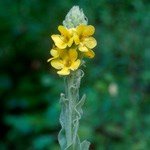
NPS photo Common Mullein, Verbascum thapsusWhile this plant is not native to North America, it has been here since Europeans came to North America. Mullein has a variety of uses. It is especially recommended for coughs and related problems. It may also fight a variety of skin problems. The plant was used to make dyes and torches. Native Americans lined their moccasins with the leaves. 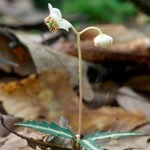
NPS photo Spotted Wintergreen, Chimaphila maculataWhile spotted wintergreen is endangered in many parts of North America, it is abundant through out the park. |
Last updated: February 22, 2023
